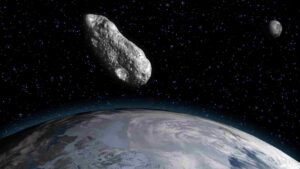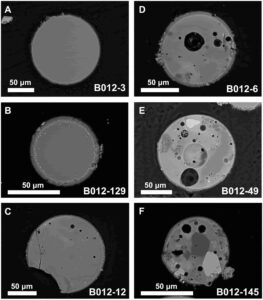
A Curtin-led research team has found asteroid impacts on the Moon millions of years ago coincided precisely with some of the largest meteorite impacts on Earth, such as the one that wiped out the dinosaurs.
The study also found that major impact events on Earth were not stand-alone events, but were accompanied by a series of smaller impacts, shedding new light on asteroid dynamics in the inner solar system, including the likelihood of potentially devastating Earth-bound asteroids.
The international research team studied microscopic glass beads aged up to two billion years old that were found in lunar soil brought back to Earth in December 2020 as part of the Chinese National Space Agency’s Chang’e-5 Lunar mission. The heat and pressure of meteorite impacts created the glass beads and so their age distribution should mimic the impacts, revealing a timeline of bombardments.

(A) Homogeneous (type 1a) glass with no clasts, schlieren, vesicles, or metal. Slight adhering regolith. (B) Sphere of homogeneous (type 1a) glass with metal around the rim. (C and D) Type 2 spheres with increasing proportion of schlieren, metal, and vesicles. (E and F) Type 3 spheres with partially digested clasts, schlieren, metal, and vesicles.
Lead author Professor Alexander Nemchin, from Curtin University’s Space Science and Technology Centre (SSTC) in the School of Earth and Planetary Sciences, said the findings imply that the timing and frequency of asteroid impacts on the Moon may have been mirrored on Earth, telling us more about the history of evolution of our own planet.
“We combined a wide range of microscopic analytical techniques, numerical modelling, and geological surveys to determine how these microscopic glass beads from the Moon were formed and when,” Professor Nemchin said.
“We found that some of the age groups of the lunar glass beads coincide precisely with the ages of some of the largest terrestrial impact crater events, including the Chicxulub impact crater responsible for the dinosaur extinction event.
“The study also found that large impact events on Earth such as the Chicxulub crater 66 million years ago could have been accompanied by a number of smaller impacts. If this is correct, it suggests that the age-frequency distributions of impacts on the Moon might provide valuable information about the impacts on the Earth or inner solar system.”
Co-author Associate Professor Katarina Miljkovic, also from Curtin’s SSTC, said future comparative studies could give further insight into the geological history of the Moon.
“The next step would be to compare the data gleaned from these Chang’e-5 samples with other lunar soils and crater ages to be able to uncover other significant Moon-wide impact events which might in turn reveal new evidence about what impacts may have affected life on Earth,” Associate Professor Miljkovic said.
The international collaboration was supported by the Australian Research Council and involved researchers from Australia, China, USA, UK and Sweden including co-authors Dr Marc Norman from the Australian National University, Dr Tao Long from the Beijing SHRIMP Center at the Chinese Academy of Geological Sciences and PhD student Yuqi Qian from the China University of Geosciences.
Reference:
Tao Long, Yuqi Qian, Marc D. Norman, Katarina Miljkovic, Carolyn Crow, James W. Head, Xiaochao Che, Romain Tartèse, Nicolle Zellner, Xuefeng Yu, Shiwen Xie, Martin Whitehouse, Katherine H. Joy, Clive R. Neal, Joshua F. Snape, Guisheng Zhou, Shoujie Liu, Chun Yang, Zhiqing Yang, Chen Wang, Long Xiao, Dunyi Liu, Alexander Nemchin. Constraining the formation and transport of lunar impact glasses using the ages and chemical compositions of Chang’e-5 glass beads. Science Advances, 2022; 8 (39) DOI: 10.1126/sciadv.abq2542
Note: The above post is reprinted from materials provided by Curtin University.










